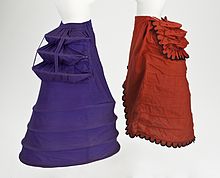Crinoline
Originally, crinoline described a stiff fabric made of horsehair ("crin") and cotton or linen which was used to make underskirts and as a dress lining.
[1][2][3][4] In the 21st century, the term crin is still used to describe a type of woven nylon flat braid, available in various widths and used for stiffening and providing bulk-free body to hemlines, serving the same purpose as the original crin/crinoline.
Whilst the bell-shaped skirts seen on statuettes from the ancient Minoan civilization are often compared to crinolines, particularly under the assumption that hoops were required to retain their shape, there is no evidence to confirm this and the theory is usually dismissed.
"[18] Following its introduction, the women's rights advocate Amelia Bloomer felt that her concerns about the hampering nature of multiple petticoats had been resolved, and dropped dress reform as an issue.
[25] The idea of inflatable hoops was short-lived as they were easily punctured, prone to collapse, and due to the use of brimstone in the manufacture of rubber, they smelled unpleasant.
[24] An advertisement published in The Lady's Newspaper in 1863 for a cage crinoline with waved hoops attempted to reassure the potential customer that while wearing it, activities such as climbing stairs, passing to her theatre seat, dropping into armchairs, and leaning against furniture would be possible without hindrance either to herself or to others around her.
[27] Whilst a loosely gathered skirt draped over a large hoop would certainly require a higher yardage, Gernsheim noted that 10 yards (9.1 m) hems were highly improbable.
[33] During the 1880s the cage crinoline was revived, with hoop petticoats designed to accommodate the extremely large bustles of the period and support the skirt hems.
[33] Due to the extreme weight of the fabrics of the decade, the hoops of the crinolines were crossed over each other behind the legs in order to support and hold the skirts firmly in place.
[37] Victoria herself is popularly said to have detested the fashion, inspiring a song in Punch that started: "Long live our gracious Queen/Who won't wear crinoline!
"[38][39] Gernsheim has noted that the Queen was often photographed in crinolines, and suggests that this misunderstanding came from a request made by Victoria that female guests attending her daughter's marriage in 1858 should leave their hoops off due to limited space in the Chapel Royal at St James's Palace.
[40] The questions of servants in crinoline and the related social concerns were raised by George Routledge in an etiquette manual published in 1875, where he criticised London housemaids for wearing hoops at work.
[41] As the girls knelt to scrub the doorsteps, Routledge described how their hoops rose to expose their lower bodies, inspiring street harassment from errand boys and other male passers-by.
[43] One, the fashion-conscious wife of a glove-maker, owned two crinolines and eleven dresses, although her usual everyday clothing consisted of wooden shoes and printed aprons.
[43] In America, the mid-19th century crinoline has become popularly associated with the image of the Southern Belle, a young woman from the American Deep South's upper socioeconomic, slave-owning planter classes.
[34] Julia Thomas, observing the extent of Punch's anti-crinoline sentiment and mockery, noted that the magazine's attacks, rather than crushing the fashion, exacerbated and even invented the phenomenon of "crinolinemania.
Her dress, "distended by a crinoline," ignited as she stood on the fender of the fireplace to reach some spoons on the mantelpiece, and she died as a result of extensive burns.
The Deputy-Coroner, commenting that he was "astonished to think that the mortality from such a fashion was not brought more conspicuously under the notice of the Registrar-General," passed a verdict of "Accidental death by fire, caused through crinoline.
"[47] A similar case was reported later that year, when 16-year-old Emma Musson died after a piece of burning coke rolled from the kitchen fire to ignite her crinoline.
[27] In 1859, while participating in a paper chase, Louisa, Duchess of Manchester, caught her hoop while climbing over a stile, and was left with the entirety of her crinoline and skirts thrown over her head, revealing her scarlet drawers to the assembled company.
[53] A report in The Cork Examiner of 2 June 1864 recorded the death of Ann Rollinson from injuries sustained after her crinoline was caught by a revolving machinery shaft in a mangling room at Firwood bleach works.
[55] This style featured wide, full mid-calf length skirts, and was described as practical (for enabling freedom of walking and movement) and patriotic, as the sight of attractively dressed women was expected to cheer up soldiers on leave.
[63] Following World War II, crinolines were once again revived by designers such as Christian Dior, whose 1947 "New Look" featured full skirts supported by stiffened underskirts.
[64][65] Loschek has suggested that, by explicitly referencing the Belle Époque era and reviving historic styles of corsets and crinolines in his "New Look," Dior was the first designer to introduce the idea of postmodernism to fashion, albeit unconsciously.
[81][86] The reason for the proposed ban was linked to the SAE racism incident earlier that year, with several articles noting it was a well-intentioned attempt to avoid the University of Georgia fraternities facing charges of racial insensitivity.
[44][86] It was noted that hoop skirts and crinolines had been worn by both black and white women of all classes and social standings during the historical period in question, and that despite popular associations, they were not exclusive to the image of the Southern Belle.












